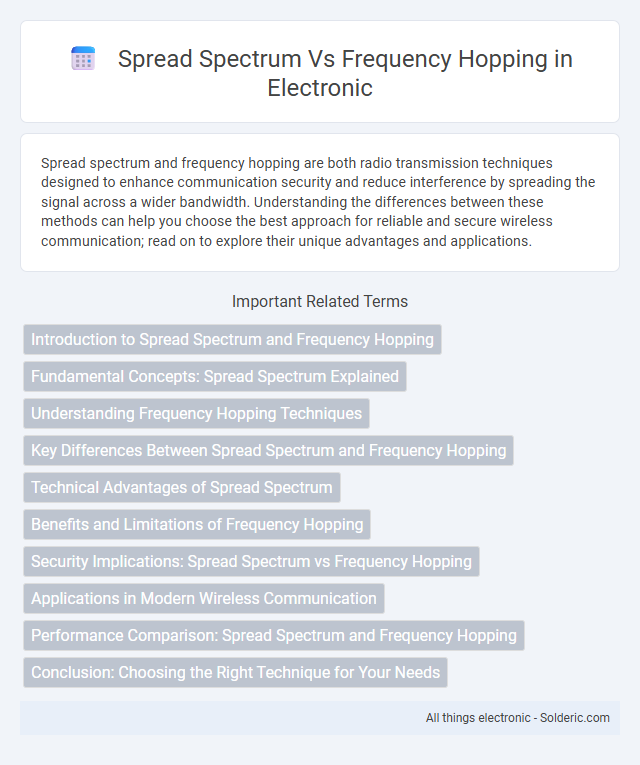Spread spectrum and frequency hopping are both radio transmission techniques designed to enhance communication security and reduce interference by spreading the signal across a wider bandwidth. Understanding the differences between these methods can help you choose the best approach for reliable and secure wireless communication; read on to explore their unique advantages and applications.
Comparison Table
| Feature | Spread Spectrum | Frequency Hopping |
|---|---|---|
| Definition | Signal spread over a wide frequency band | Rapidly switching frequencies within a band |
| Technique | Direct Sequence Spread Spectrum (DSSS) | Frequency Hopping Spread Spectrum (FHSS) |
| Bandwidth | Wideband spectrum usage | Multiple narrowband frequencies |
| Interference Resistance | High resistance to narrowband interference | Good resistance, depends on hopping pattern |
| Security | High due to spreading code | High due to unpredictable hopping |
| Synchronization | Requires accurate code synchronization | Requires precise timing for hopping |
| Complexity | Moderate to high | High due to frequency control |
| Applications | GPS, CDMA, Wi-Fi (DSSS) | Bluetooth, military communications |
Introduction to Spread Spectrum and Frequency Hopping
Spread spectrum is a wireless communication technique that spreads a signal over a wide frequency band to improve resistance to interference and eavesdropping. Frequency hopping, a subset of spread spectrum, rapidly switches the carrier frequency across multiple channels according to a pseudo-random sequence to enhance security and reduce signal jamming. Both methods are vital in military and commercial applications for secure, reliable data transmission.
Fundamental Concepts: Spread Spectrum Explained
Spread spectrum is a communication technique that involves spreading the signal over a wider frequency band than the minimum required, enhancing resistance to interference and eavesdropping. Frequency hopping, a subtype of spread spectrum, rapidly switches the carrier among many frequency channels according to a pseudorandom sequence known to both transmitter and receiver. These methods improve signal security and robustness, making them essential in military and wireless communication systems.
Understanding Frequency Hopping Techniques
Frequency hopping is a spread spectrum technique that rapidly switches carrier signals among multiple frequency channels according to a pseudorandom sequence, enhancing security and resistance to interference. This method improves signal robustness in crowded or hostile environments by minimizing the likelihood of signal jamming and eavesdropping. Key applications include military communications and Bluetooth technology, where frequency hopping maintains reliable connections amid dynamic radio frequency conditions.
Key Differences Between Spread Spectrum and Frequency Hopping
Spread spectrum technology distributes a signal across a wide frequency band to reduce interference and enhance security, while frequency hopping rapidly switches the carrier among multiple frequencies within that band to prevent eavesdropping and jamming. The key difference lies in their operational approach: spread spectrum continuously spreads the signal, whereas frequency hopping transmits short bursts on varying frequencies in a pseudo-random sequence. Understanding these distinctions helps you choose the appropriate method for secure and reliable wireless communication applications.
Technical Advantages of Spread Spectrum
Spread spectrum technology offers significant technical advantages, including enhanced resistance to interference and jamming, which ensures more reliable communication in noisy environments. Its ability to distribute signals over a wide frequency range reduces the likelihood of signal interception and improves security, making it ideal for military and secure communications. Your wireless system benefits from better signal integrity and reduced multipath fading, resulting in improved overall performance compared to frequency hopping techniques.
Benefits and Limitations of Frequency Hopping
Frequency hopping offers robust resistance to interference and eavesdropping, enhancing communication security by rapidly switching frequencies according to a pseudorandom sequence. Its primary limitation lies in complexity and synchronization requirements, which can increase system cost and reduce efficiency in high data rate transmission. You benefit from improved immunity to narrowband interference, but need to manage challenges in maintaining precise frequency coordination between sender and receiver.
Security Implications: Spread Spectrum vs Frequency Hopping
Spread spectrum techniques, including direct sequence spread spectrum (DSSS), provide robust resistance to signal jamming and eavesdropping by spreading the signal over a wide frequency band, making interception and interference more difficult. Frequency hopping spread spectrum (FHSS) enhances security by rapidly switching carrier frequencies according to a pseudorandom sequence, reducing the probability of interception and making targeted jamming more complex. Both methods improve communication security, but FHSS offers superior protection against narrowband jamming and unauthorized access due to its dynamic frequency agility.
Applications in Modern Wireless Communication
Spread spectrum technology and frequency hopping are essential techniques in modern wireless communication, enhancing security and resistance to interference. Spread spectrum is widely used in Wi-Fi, GPS, and CDMA cellular networks due to its ability to spread signals over a wide bandwidth, improving signal robustness and reducing eavesdropping risks. Frequency hopping, employed in Bluetooth technology and military communications, rapidly switches carrier frequencies to minimize the impact of narrowband interference and prevent signal jamming.
Performance Comparison: Spread Spectrum and Frequency Hopping
Spread spectrum techniques, including direct sequence and frequency hopping, enhance communication reliability by minimizing interference and improving signal security. Frequency hopping offers increased resistance to narrowband interference and jamming by rapidly changing frequencies, while direct sequence spread spectrum provides better performance in multipath environments due to signal spreading over a wider bandwidth. Your choice depends on whether your application prioritizes resistance to interference or multipath performance for optimal communication integrity.
Conclusion: Choosing the Right Technique for Your Needs
Spread spectrum offers robust resistance to interference and enhances security by spreading signals across a wide bandwidth, making it ideal for environments with high noise levels. Frequency hopping provides superior resilience to narrowband interference and jamming by rapidly switching frequencies, which is well-suited for dynamic, hostile communication channels. Selecting the right technique depends on factors such as interference type, security requirements, and application environment, ensuring optimal performance and reliability.
spread spectrum vs frequency hopping Infographic

 solderic.com
solderic.com